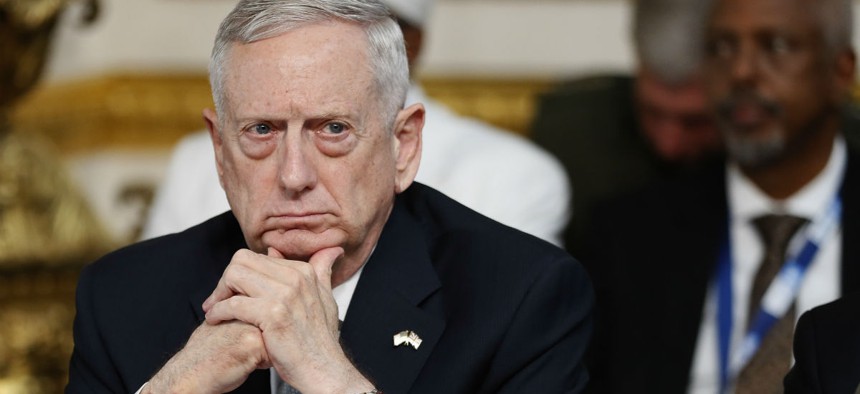
Secretary of Defense James Mattis listens during a National Security session at the 2017 Somalia Conference in London on May 11. AP Photo/Kirsty Wigglesworth
Mattis Fills Key Executive Positions at the Pentagon
Former official: Defense Secretary James Mattis’ political SES appointments are mainstream choices.
Defense Secretary James Mattis began to fill out his staff last week, announcing his choices for three key positions at the department. Experts said the appointees seem well qualified and broadly in line with that of his predecessors.
Mattis named Elbridge Andrew Colby to serve as deputy assistant secretary for strategy and force development. Colby most recently was a Robert M. Gates Senior Fellow at the Center for a New American Security, a national security think tank that produced several appointees in the Obama administration.
He tapped Pete Giambastiani to become principal deputy assistant secretary for legislative affairs. A Naval Academy alumnus, Giambastiani most recently worked as chief of staff to Rep. Tom Rooney, R-Fla., a member of the House Appropriations and Intelligence committees. During the George W. Bush administration, Giambastiani served as a special assistant to the deputy undersecretary of the Navy and the secretary of the Navy.
And Thomas Goffus was named deputy assistant secretary for Europe and NATO. Goffus, a retired Air Force colonel, most recently served as a staffer on the Senate Armed Services Committee.
All three posts are Senior Executive Service positions. Bill Valdez, president of the Senior Executives Association, said the appointments are among the 800 SES slots that can be used for political hires.
“From an SEA point of view, we treat these like any other political appointment—it’s at the president’s discretion—and the short answer is it doesn’t really matter who they are,” Valdez said. “This is who the president wants on the job.”
Valdez said that 7,200 of the 8,000 SES appointments authorized by the 1978 Civil Service Reform Act are reserved for career federal employees. The last 10 percent can be used by any administration for political appointees.
“They can serve up to three-year appointments, and those can be renewed by the [department] secretary or whomever,” he said. “The agency head is the one who usually fills those positions, but that happens in close consultation with the White House, because they tend to be very high-level appointments.”
Stan Soloway, who served as deputy undersecretary of Defense for acquisition reform and the director of Defense reform from 1998 to 2001, described the appointees as “pretty standard.”
“Some folks can be confused by the titles—there have been a lot of ‘title changes’ in the last five to 10 years,” Soloway said. “But these are traditional political positions that are a normal part of the SES corps. And while I don’t know the individuals personally, their backgrounds suggest they fit with the positions to which they’ve been appointed.”







